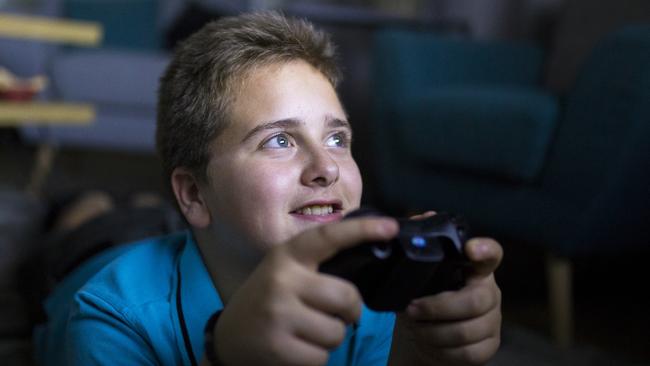Australian teens spend 49 hours a week on digital devices
An alarming insight into the habits of Australians shows boys hooked on video games and girls exposed to some of the world’s worst cyber-bullying. Parents face a risk of ‘rebellion’.

Australian teenagers average 49 hours a week glued to digital devices, with boys hooked on video games and girls exposed to some of the world’s worst cyber-bullying.
A global survey of 15-year-old students shows that 12 per cent of Australian teenagers spend more than 80 hours a week including time spent using computers for schoolwork.
For leisure, nearly one in five Australian “screenagers” spends at least 40 hours a week scrolling through social media or playing video games, a new Organisation for Economic Co-operation and Development report reveals.
More than half Australia’s 15-year-olds spend at least two hours each weekday using digital devices for leisure – in breach of the federal Health Department’s advice that kids spend no more than two hours a day on screens.
Nearly one in five Australian teenagers spends more time playing online than studying at school.
On weekdays, 39 per cent of teenagers spend at least three hours a day scrolling through social media, while 29 per cent game for more than three hours before or after school.
Spelling out the dangers and damage of digital addictions, the OECD report warns of cyber-bullying, exposure to violence and pornography, sleep deprivation, obesity, and interference with children’s brain development.
Policing kids’ online behaviour is one of the biggest challenges of modern parenting, it says, triggering conflicts between parents and their children.
“Parents are generally anxious about the amount of time children and teenagers spend playing video games, surfing the internet, and using social media applications, over which they have limited control,’’ the report states.
But the OECD report also chides parents for spending too much time online instead of playing with their children, and exposing their kids to pedophiles by posting photos and videos online.
“Technological distractions, such as background television or parental use of mobile devices, can diminish the quality and quantity of both solitary and parent-child play,’’ it states.
“Sharenting’’ – where parents “gain gratification from posting stories, images and videos of their children’’ – raises concerns for kids’ privacy.
“Parents may disclose personal information without their child’s consent,’’ the report states.
“Sharenting can also expose children to risks like online grooming, pedophiles and identity theft.’’

The OECD report reveals that boys are more prone to gaming addictions, while girls are more likely to have problems with social media and mobile phone use.
“Globally, girls are more likely to use social media intensively and report being more often affected by exposure to inappropriate content or hate speech,’’ it states.
“Boys are more likely to engage in risky digital behaviours; they tend to spend excessive amounts of time playing video games, enable notifications on their devices when they go to bed, participate in cyber-bullying, and more frequently recklessly share online information they know to be untrue.’’
Spending more than two hours a day online is linked to depression, anxiety, body image concerns and poor sleep, the report says. But some online games are engineered to be addictive.
“Structural features of games, such as in-game rewards that trigger dopamine release and the unpredictability of these rewards, play a key role in reinforcing prolonged gaming sessions and sustaining gaming disorders,’’ the report, titled How’s Life for Children in the Digital Age?, states.
“Strict time limits may provoke rebellion or withdrawal systems,’’ it adds.
The OECD casts doubt on the effectiveness of Australia’s world-first ban on under-16s setting up social media accounts, due to take effect in November.
“Access to digital services and devices is already deeply integrated into children’s lives from a young age, making it difficult to reverse the trends, and raising questions about the effectiveness of such measures,’’ it states.
“(A ban faces) challenges in enforceability, potential circumvention, and implications for children’s rights and digital participation.’’
The OECD calls on social media and gaming companies to safeguard children’s health and welfare online, insisting that the responsibility cannot rest with teenagers and parents.
Virtual reality games, the OECD report warns, can “blur the line between virtual and real experiences’’ for young children, while “fast-paced content may hinder cognitive and executive skill development’’.
The OECD findings are based on a survey of 690,000 students from 81 countries, including 13,500 students from 743 schools in Australia, who were asked about their time using digital devices as part of the 2022 Program for International Student Assessment literacy and numeracy test.

Australian students spend twice as much time online as teenagers in Japan, but the report notes that Japanese students have “demanding school and extra-curricular schedules’’ that leave little time to relax.
The data shows 18.5 per cent of Australian teens spend more than 40 hours a week online for leisure – fewer than the 22.5 per cent averaged across industrialised countries but much higher than the 5.8 per cent in Japan.
The OECD warns that online violence and pornography can be distressing for children and harm their development.
“Pornography has never been more accessible to children and adolescents,’’ it states.
“Pornography often depicts distorted or unrealistic portrayals of sex and relationships, which can affect children’s understanding of healthy sexual behaviour and consent.
“Repeated exposure to explicit content can desensitise children, potentially affecting their future relationships.
“Exposure to violent or gory content can be disturbing or traumatising for children. It can create conditions that perpetuate dangerous practices, such as self-harm, which is increasingly frequent among teenagers, particularly girls.’’
Australian girls’ levels of distress are among the highest in the industrialised world, with 60 per cent saying they got upset when they received unkind, vulgar or offending messages, comments or videos online – more the OECD average of 45 per cent and 30 per cent of girls in Japan.
Eating disorders can be triggered or worsened by social media content regarding body image, beauty norms or dietary habits, the report warns.
“Social media platforms, where adolescents are highly active, often promote and normalise idealised and stereotypical beauty standards, a trend further reinforced by the use of filters and photo editing software,’’ it states.
“Being exposed to such imagery can foster a negative self-perception, leading to feelings of dissatisfaction and despair.’’
The report also notes the growing trend of “sextortion’’, as criminals impersonate teenage girls to coerce boys into sending sexualised images – then blackmail them for money or details of parents’ credit cards and bank accounts.
Pedophiles are also contacting children online, it warns.
The Australian Federal Police has urged parents to talk to their children about the risk of “sextortion’’ and to seek help if they are targeted.







To join the conversation, please log in. Don't have an account? Register
Join the conversation, you are commenting as Logout